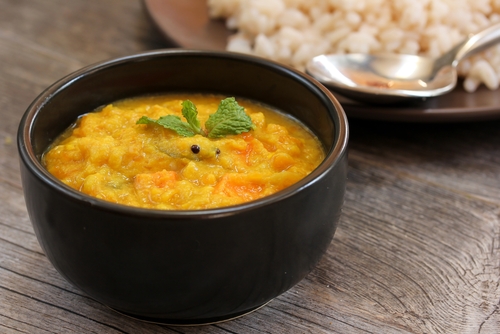Kitchari (Kitch – a – ree)
Means: “Mixture” “mess of pottage” “stew” or “porridge”
I learned about the wonders of the Indian dish kitchari earlier this year while I was living and working at a yoga retreat centre. Every morning were greeted with beautiful and aromatic pot of the warming lentil dish for breakfast. I worked mornings in the kitchen so I was blessed with making this dish every nearly every day for a couple of months. I learned that it can be a very simple or very complicated dish depending on the cook and that it can have a large number of variations. Each version is both delicious and highly nutritious, filling and comforting.
It is naturally easy to digest, due to its simple ingredients and the fact that they are prepared by soaking and rinsing. Traditionally made with rice and mung beans, the dish is usually spiced lightly with mustard seeds, turmeric, coriander and lots of ginger. It is a warming dish and stimulates the digestive system allowing for natural detoxing and cleansing. Ayurvedic practitioners swear by kitchari for its healing qualities. It purifies the digestive tract and cleanses the body of toxins. It is used in the breaking of fasts, recuperating from illnesses and is also a calming food for times of stress. In Ayurvedic medicine, kitchari is considered to be the “food of the gods” and is the “cornerstone of the Ayurvedic diet”
The dish is made from a mixture of grain and pulse, traditionally mung beans and basmati rice, ghee (clarified butter) and warming spices. It can be made with any kind of split legume, like, red lentils, or split peas for example, and it is often made with brown rice, but can also be made with any grain, like millet or buckwheat. Most versions I have tried tend to also have some sort of vegetable in it, like carrot or potato and zucchini.
Kitchari is considered Sattvic; Sattva (Sanskrit: सत्त्व) is one of the three Guṇas (tendencies, qualities, attributes), a philosophical and psychological concept developed by the Samkhya school of Hindu philosophy. The other two qualities are rajas (passion and activity) and tamas (destruction, chaos).
Tamas – Density, inertia
Rajas – Movement, disturbance
Sattva – Knowledge, balance.
In yoga, they teach that we must always strive for sattva in all things. That we will always have tendancies towards both tamas and rajas, but to always try to keep sattvjc; the highest of all the gunas. This will keep us balanced and clear minded in our lives, allowing us to achieve our goals and live a happy life.
In everyday life there is a difference in how each guna makes you feel, react and respond to situations. When in a state of laziness and stillness, it is difficult to find motivation to get off the coach, go to work, or to shut down our computers, this state is tamas. To get ourselves out of that lethargic state, we force ourselves to have energy to get ourselves into gear, this is us inviting rajas Most people live in a constant state of tamas and rajas, bouncing back and forth between the two all day long. Sattva is a state of calm, clean energy and clear headedness. If you have ever been to a yoga class, you will likely have felt that feeling after arising from the final pose of Savasana -corpse pose. This feeling is often referred to as the yoga high. I also experience Sattva when I am outdoors in a beautiful place, looking at mountains, or gazing at a beautiful sunset.
We can help ourselves achieve or find more sattva in all aspects of our lives, from our actions, to our thoughts and even in the things we eat.
Kitchari is considered a purely sattvic food, because it is vegetarian.
Kitchari: (Kitch- ah -ri)
Ingredients:
- 2 Cups brown rice
- 2 Cups moong dahl lentils (or red lentils) You can find the moong dahl lentils at the bulk store, they are yellow in colour and not circular, but oval in shape.
- Soak the rice and lentils overnight and rinse thoroughly before cooking. Boil a kettle full of water (you will use this later)
- 1 Tbsp Turmeric
- 1 T Cumin
- 1/2 T Coriander
- 1/2 T Ginger powder
- 2 Tbsp black mustard seeds
- 2 Tbsp fenugreek seeds (or powder)
- 1 pinch of nutmeg
- 1 cup fresh grated ginger root
- 2 Tbsp coconut oil
- 1 bunch of fresh cilantro (with the roots if you can find it.
- 2-5 grated carrots, or potatoes or sweet potatoes (skin on, and washed.)
- 2-3 grated zucchini
Cooking Instructions:
Start with the coconut oil in a pot on med-high heat. Put in the mustard seeds and sauté until you hear all of them pop. Put the remaining spices in the pot and cook until they are fragrant. It does not take long, and be careful not to burn the spices.
Add the soaked grains and stir until they are covered in spice. Pour the boiling water into the pot and stir. Add the chopped roots of the fresh cilantro and the grated carrot or potato, whichever you choose. For ease of digestion, this dish is meant to only have 2 different kinds of vegetables one of them a starch, which ones you choose is up to you.
Add the fresh ginger root. Cover with a lid and bring to a simmer. The cooking time is long, around an hour and a half. You will likely have to add more water while it is cooking. You are aiming for the lentils to lose their shape and disintegrate, and the thickness should be something like a thick stew.
When the lentils have disintegrated, add the zucchini and fresh cilantro leaves and cover, turn off the heat and let sit for a 1/2 hour.
Before serving season with salt and pour a generous amount if olive oil over top and stir in. Serve with fresh lemons to squeeze on top.


